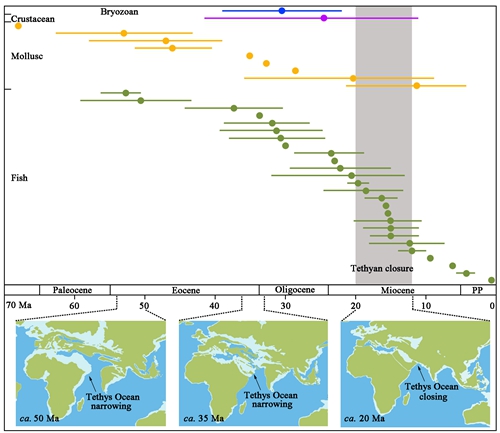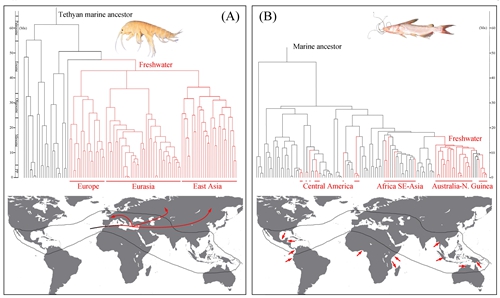The Tethys Ocean existed between the continents of Gondwana and Laurasia, and the Tibetan Plateau was covered by the Tethys 65 million years ago (Ma). The Eocene collision of Eurasia and Africa/India led to the westward retreat of the Tethys. The Miocene drift of the Arabian Plate closed the Tethys Ocean and it vanished 5.5 Ma during the Messinian Salinity Crisis. The Tethys once covered present-day Alps, Tibetan Plateau and Indo-West Pacific islands. The Tethys Ocean experienced a succession of complex geodynamic events, and shaped the modern patterns of species richness.
Tethyan changes shaped the present-day sea basins. Analyses of multiple phylogenetic histories on mollusc, crustacean, bryozoan and fish reveal that the Tethyan vicariant event have shaped today's marine biodiversity distribution. The opening of the Atlantic Ocean is responsible for the earliest isolation between the West and East Atlantic. The mid-Miocene closure of the Tethys isolated the Atlantic/Mediterranean Sea and Indo-West Pacific. And formation of Isthmus of Panama drove the split of East Pacific and West Atlantic. The ancestral Tethyan realm broke into five biogeographic provinces, including the East Pacific, West Atlantic, East Atlantic, Mediterranean Sea, and Indo-West Pacific. The Tethyan changes created vast shallow-marine habitats, and drove the shift of marine hotspot from the western Tethys to the Indo-West Pacific region.
The Tethyan changes open up new ecological opportunities for Eurasian biodiversity. Continental plate movements uplifted marginal mountain ranges and Tethyan regression resulted in the emergence of new freshwater habitats. Molecular phylogenies of Gammarus crustaceans indicate an ancient marine–freshwater transition. A habitat shift provided ecological opportunities with unoccupied niches for exploitation by marine ancestor, leading to a rapid diversification and rang expansion in Eurasia. However, researches on fish show that marine–freshwater transition occurred repeatedly, and their freshwater distributions are not far from the sea.
"Out of Tethys" might be an important mode to clarify diversification patterns in China. The research group led by Shuqiang Li seeks to understand how Tethyan changes and Tibetan uplifting influence the diversification of species. The studies on aquatic Gammarus confirmed an Tethyan origin of freshwater species in China, and a recent paper on spiders showed that uplifting of the Tibetan Plateau and Tethyan regression drove the rapid radiation across Eurasia.
This study answered the essential question about the biological impact of the Tethyan changes, explored the global diversification patterns, and presented the origin of Chinese biodiversity.
The relevant paper entitled "Tethyan changes shaped aquatic diversification" is published online in Biological Reviews on October 12, 2017. This work was supported by the National Natural Science Foundation of China (NSFC-31422048, 31530067), and the Southeast Asia Biodiversity Research Institute, Chinese Academy of Sciences (2015CASEABRI005, Y4ZK111B01).
http://onlinelibrary.wiley.com/doi/10.1111/brv.12376/full

The spits between Atlantic/Mediterranean and Indo-West Pacific clades in fishes, molluscs, crustaceans and bryozoans.

Alterative hypotheses from marine鈥揻reshwater transition.
Contact:
Shuqiang Li, PhD
Key Laboratory of Zoological Systematic and Evolution, Institute of Zoology, Chinese Academy of Sciences, 1 Beichen West Rd, Chaoyang District, Beijing 100101, China;
Email: lisq@ioz.ac.cn


